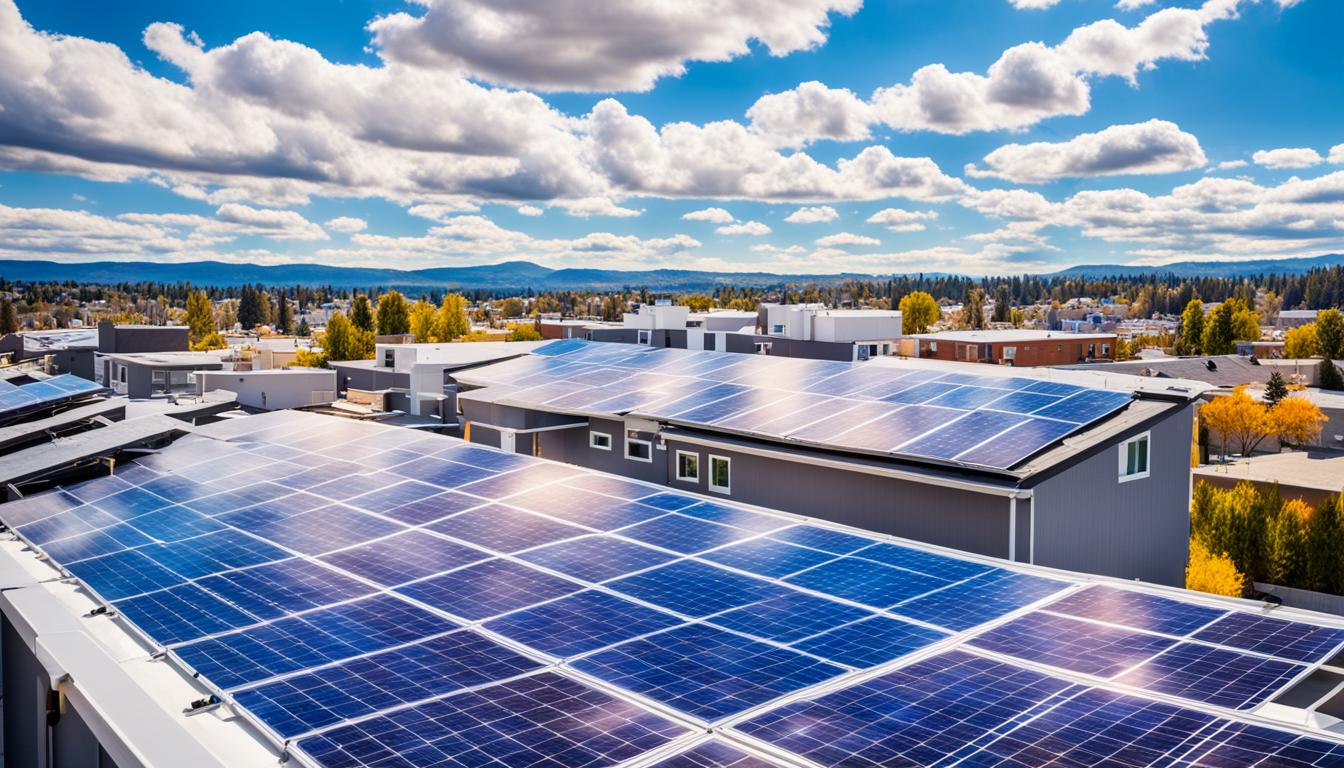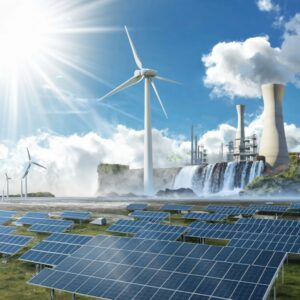
Welcome to our guide on getting rewarded for picking solar energy. By adding solar PV systems, you help the earth and save money. I’ll show you how solar energy rebates and tax credits cut costs and boost savings, moving you towards a greener future.
Key Takeaways:
- Installing solar PV systems can provide financial incentives and savings.
- Solar energy rebates can significantly reduce the upfront cost of installations.
- Tax credits, such as the federal investment tax credit (ITC), can further reduce your overall costs.
- Research and understand the eligibility criteria and requirements of these incentives to maximize your benefits.
- Going green with solar energy benefits both the environment and your wallet.
Finding Solar Rebates: How to Lower Your Solar Installation Costs
As a homeowner, you can cut your solar costs with rebates. These rebates come from many places like your state or local government, utility companies, installers, and equipment makers.
Local governments and utilities often offer the biggest savings, sometimes over $5,000. Getting these rebates can reduce the money you need upfront. This makes going solar cheaper.
But, applying for rebates means sharing a lot of details about your system and its costs. Make sure to check if there are specific equipment or system size rules. Understanding these could help you get the rebates you need.
Comparing quotes from different installers helps you find the best deal with rebates. Some installers might raise prices with rebates. So, looking at many quotes can show you who gives a fair price and good service.
It’s also smart to look at brands that offer rebates or work with platforms like EnergySage. Their deals can drop your solar system costs even more. This makes switching to solar power financially smart.
“By taking advantage of solar rebates, homeowners can not only lower their installation costs but also contribute to a greener future. It’s a win-win situation for both your wallet and the environment!”
Benefits of Solar Rebates
Solar rebates make going solar a great choice for a few reasons:
- Financial savings: They can lower the start-up cost for a solar system. This helps homeowners save money right away.
- Accelerated payback period: With cheaper installation, you’ll start saving money sooner. It speeds up how fast you make back your investment.
- Increased return on investment: Rebates help you get more from your solar energy investment. They lead to saving money over a long time.
- Environmental impact: Solar power is good for Earth. It uses less fossil fuels, lowers greenhouse gases, and helps our planet.
Finding Solar Rebates: A Step-by-Step Guide
Here’s how to find and get solar rebates:
- Look into local government and utility rebates on their websites. Find out what you need to do to get these savings.
- Talk to solar installers to see what rebates or deals they have. Get quotes from several to pick the best one for you.
- Check if solar equipment brands you’re looking at offer any discounts. Some have special deals if you buy and use their products.
Spending time to look into these options can save you a lot on solar costs. By using rebates, you can make the move to solar energy and save on your bills for the future.

Taking Advantage of Tax Credits: Maximizing Your Savings
Homeowners can save a lot with solar rebates and tax credits. The federal investment tax credit (ITC) is a big one. It lets homeowners claim 30% of their solar system’s cost on their taxes. This can reduce what they owe in taxes or give them a refund.
The ITC cuts the cost of solar systems for homeowners. But, this tax credit starts to reduce in 2033 and will end in 2035. Homeowners should act fast to save more before the tax credit goes down or disappears.
Some states have their own solar tax credits. Homeowners should check what their state offers. It could mean even more savings for them.
Some areas also don’t charge property or sales tax on solar systems. These perks make going solar even more affordable for homeowners.
Let’s look at how tax credits can help with savings:
| System Cost | Tax Credit (30% ITC) | Out-of-Pocket Expense |
|---|---|---|
| $20,000 | $6,000 | $14,000 |
| $30,000 | $9,000 | $21,000 |
| $40,000 | $12,000 | $28,000 |
As the table shows, the ITC can lower what homeowners need to pay upfront. This means they see the benefits, like lower electricity bills, faster.
By using tax credits wisely, homeowners can afford to go solar and save money. Getting advice from tax professionals or solar experts is key to using these credits well.

Don’t forget about tax credits when going solar. They, along with solar rebates, can cut costs significantly. This helps homeowners build a greener future and save cash.
Conclusion
Solar energy rebates and tax credits are great financial incentives to motivate homeowners to go green. They help in reducing the cost of solar panel systems. Also, homeowners can save a lot on their energy bills in the long run.
It’s vital for homeowners to check the criteria and requirements for these incentives. This way they can get the most out of the benefits.
Choosing solar power is not just good for the Earth, it’s also good for your wallet. By going solar, you can become more self-sufficient and reduce the use of harmful fossil fuels. You’ll play a part in making the world cleaner and greener for the future.
There are many solar energy rebates and incentives out there. This makes it the perfect time to switch to renewable energy. So, you can enjoy not only a cleaner future but also start saving money.
Begin your green journey now and start making savings. With a solar PV system, you can lower your carbon footprint. Plus, you get to enjoy the financial benefits that it brings.
Use solar energy rebates and tax credits to make cleaner energy more affordable. Let’s work together to help the environment and save money at the same time.






